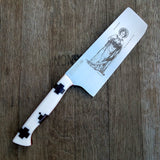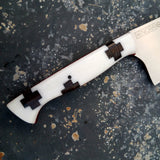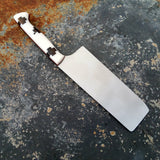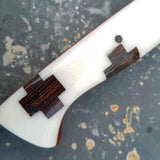










NORA #1227 - Saint Elizabeth of Hungary
$ 360.00
KNIFE HIGHLIGHTS
- Blade Type: Nakiri
- Blade Length: 6.5 Inches
- Total Length: 11.75 Inches
- Handle Style: Western | Right or Left Hand Use
- Steel: AEB-L Stainless Steel
- Handle Materials: Pearl White Urethane based resin, stabilized wenge wood, black micarta pins, Black/Red G10 liners
- Rockwell Hardness: 62 HRC
- Grind Type: Full Flat
- Weight: 8.9 oz.
- This Blade is Ground...
- Thin for Performance (best performance but delicate)
- Thick for Durability (tough, built to last for heavy wear-n-tear)
- >>>Mid-Range with Special Geometry (good performance but blade is kept slightly thicker for durability)
- This Knife Feels...
- >>>Heavy in Hand (hefty, durable)
- Light (nimble, maneuverable)
- Not too heavy, not too light (Switzerland)
GENERAL USES OF THIS KNIFE
NAKIRI
The Nakiri knife is a Japanese style knife that is specifically designed to excel at cutting and prepping vegetables and greens. These blades are very thin and literally fall through food. Because of the thinness, these blades should not be used for cutting through any type of bone or harder objects but you would be surprised at the versatility of the Nakiri. We find we use ours for a wide array of tasks in the kitchen - everything from protein prep to bread.
The blade height is just over 2 inches which is larger than many other Nakiri's but we find it helps keep your knuckles off the board and it works well with many larger vegetables.
STEEL INFORMATION:
AEB-L STAINLESS STEEL
This knife blade is composed of AEB-L stainless steel which is a high-quality Swedish metal, originally developed for razor blades. Recently, steel suppliers have made this steel available in thicker sheets and it has proven to be an excellent adaptation for the cutlery industry.
AEB-L has a beautiful balance of carbon and chromium and, with proper heat treatment, this steel produces both a very fine edge as well as excellent toughness and edge stability. The fine grain structure also makes this steel very easy to sharpen. We believe it is one of the finest stainless steels available on the market today for use with kitchen knives.
As a side note, there are two things we like to mention about this steel:
1.) This steel responds beautifully to honing and if the knife is honed regularly it should need infrequent sharpening.
2.) AEB-L is a stainless steel but just barely. The concept of stainless steel is actually misleading because every steel is, at some level, reactive to water and other elements.
The higher carbon content in this stainless is what allows it to get a fine edge and higher hardness than other stainless steels but it also has a tendency to sometimes form very fine rust spots on the blade. If this happens, these are easily removed with a green or red scotch brite pad and usually the rough end of a kitchen sponge will also do the trick. Take extra care to remove an excess wetness that remain on this blade. Drip drying is not recommended.
HANDLE DESIGN & MATERIALS:
Every one of our knives is handmade, unique and numbered. NORA#1227 is a custom, one-off design and one of two Saint Inspired Knives.
We started on this knife by cutting a number of small, swiss cross style pieces from a block of stabilized wenge-wood. We then casted white resin around these pieces to complete the handle design. We added black and red G10 liners for added durability.
To complete the design we custom engraved an actual antique painting of Saint Elizabeth of Hungary, the patron saint of baking. Saint Elizabeth was a princess of the Kingdom of Hungary, and a greatly venerated Catholic saint who was an early member of the Third Order of St. Francis, by which she is honored as its patroness.
Elisabeth evidently became the patron saint of baking (and food) after rejecting the comforts of court life in favor of distributing food and, bread in particular, to the poor.
Princess Elizabeth is often associated with the Miracle of Roses which is what she is holding in her dress on the engraving on the knife. As the story goes, Elizabeth was descending from the family castle secretly carrying bread, eggs and meat hidden under her dress mantle. She intended to distribute the food to the poor but the practice was frowned upon by her family. While en route, Elizabeth is encountered by her husband who, upon seeing the bulk of her dress, inquires as to what she has. Flustered and mute Elizabeth knows not what to do. But as her husband grabs at her dress to discover what lies hidden he is surprised to find a bouquet of blooming, beautiful roses in the dead of winter. Hence, a miracle of roses.
I can only hope God will be so gracious to grant me the same favor next time I am caught by my husband sneaking Oreo's out of the pantry. Sigh.
CUSTOM ENGRAVING
**This knife has been custom engraved. The engraving was done via laser so there is depth to the engraving more so than you see with an electro etch. We do, however, keep the depth minimal so it does not catch food and minimally interferes with the primary cutting function of the knife. A small amount of stickage is normal around the engraved area, especially initially. This will lessen over time as the blade is used. Please note though, if performance is your #1 priority then we encourage you to NOT purchase this blade. A blade with no engraving WILL have a smoother glide than a blade with engraving. For most, however, this difference is so minimal that it is barely noticed. We just like to provide a full disclosure up front so you know exactly what you are purchasing.
The engraving should last as long as the knife but please note that it will slightly degrade over time as abrasives are used on the knife. We recommend the soft end of a sponge with soap and water for cleaning and mineral oil periodically to condition the blade (and handle). Keep in mind that stronger abrasives, such as steel wool, scotch brite pads, sand paper or stone sharpening directly on the engraved image will further degrade the image.
